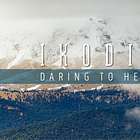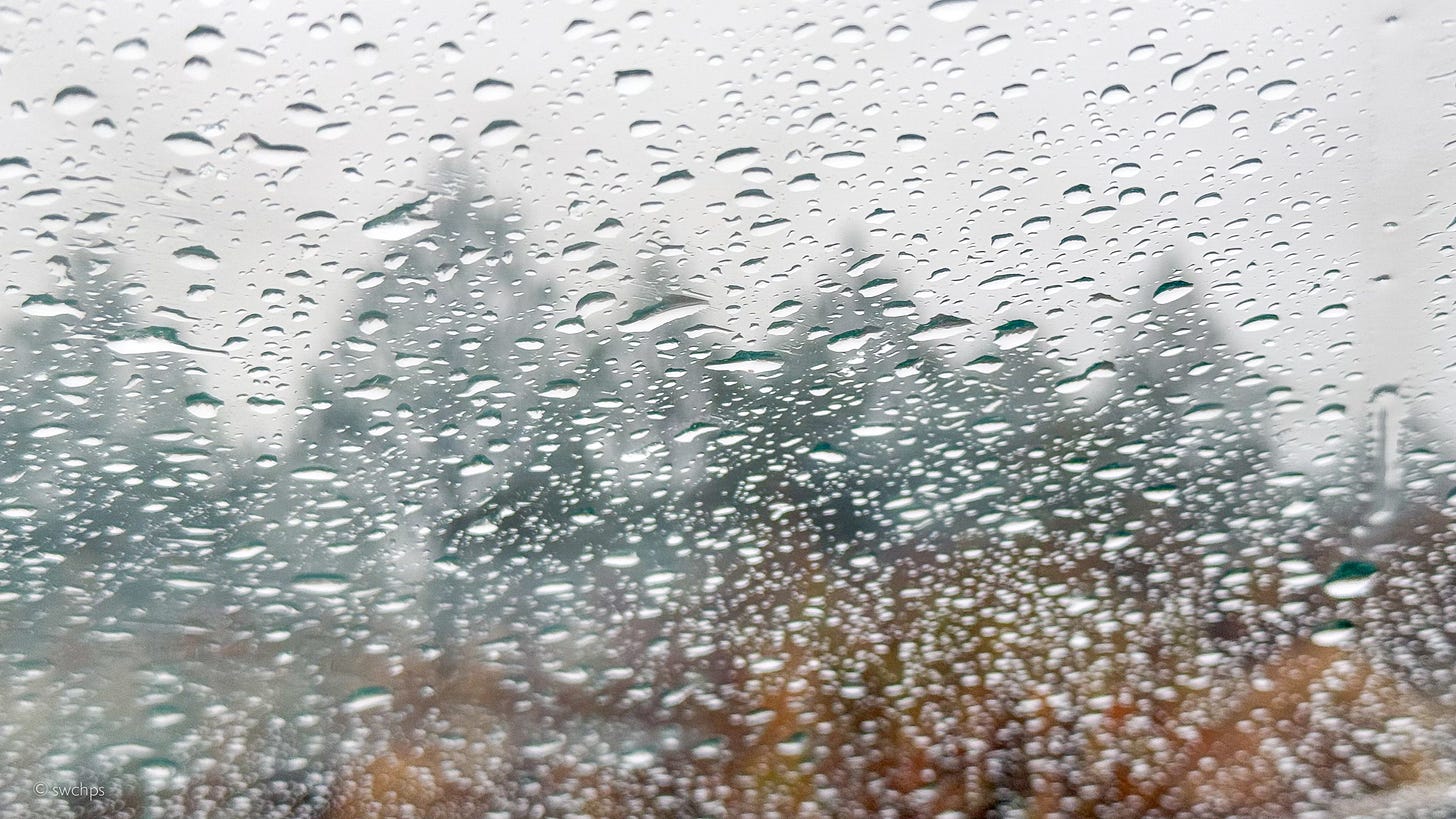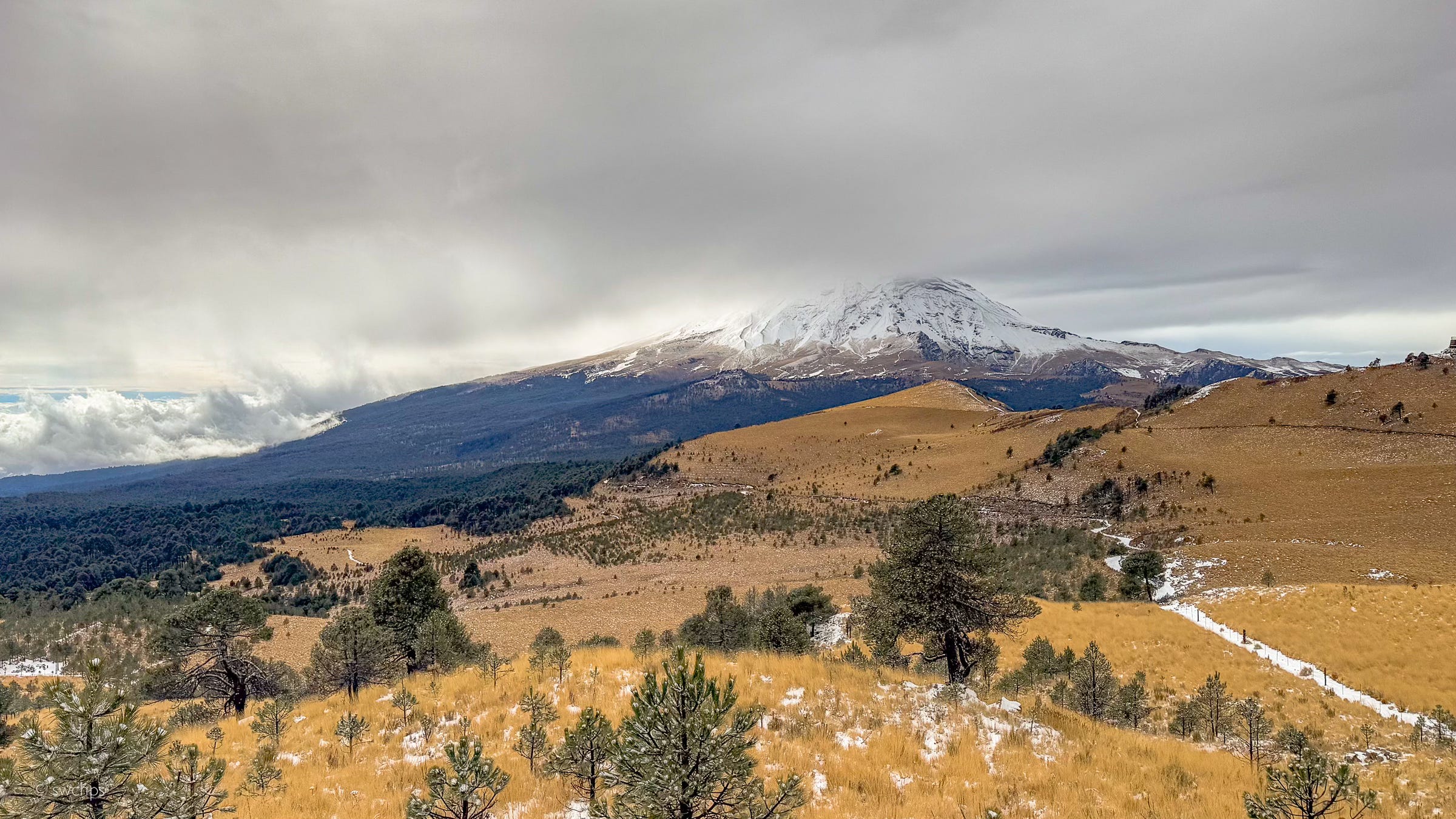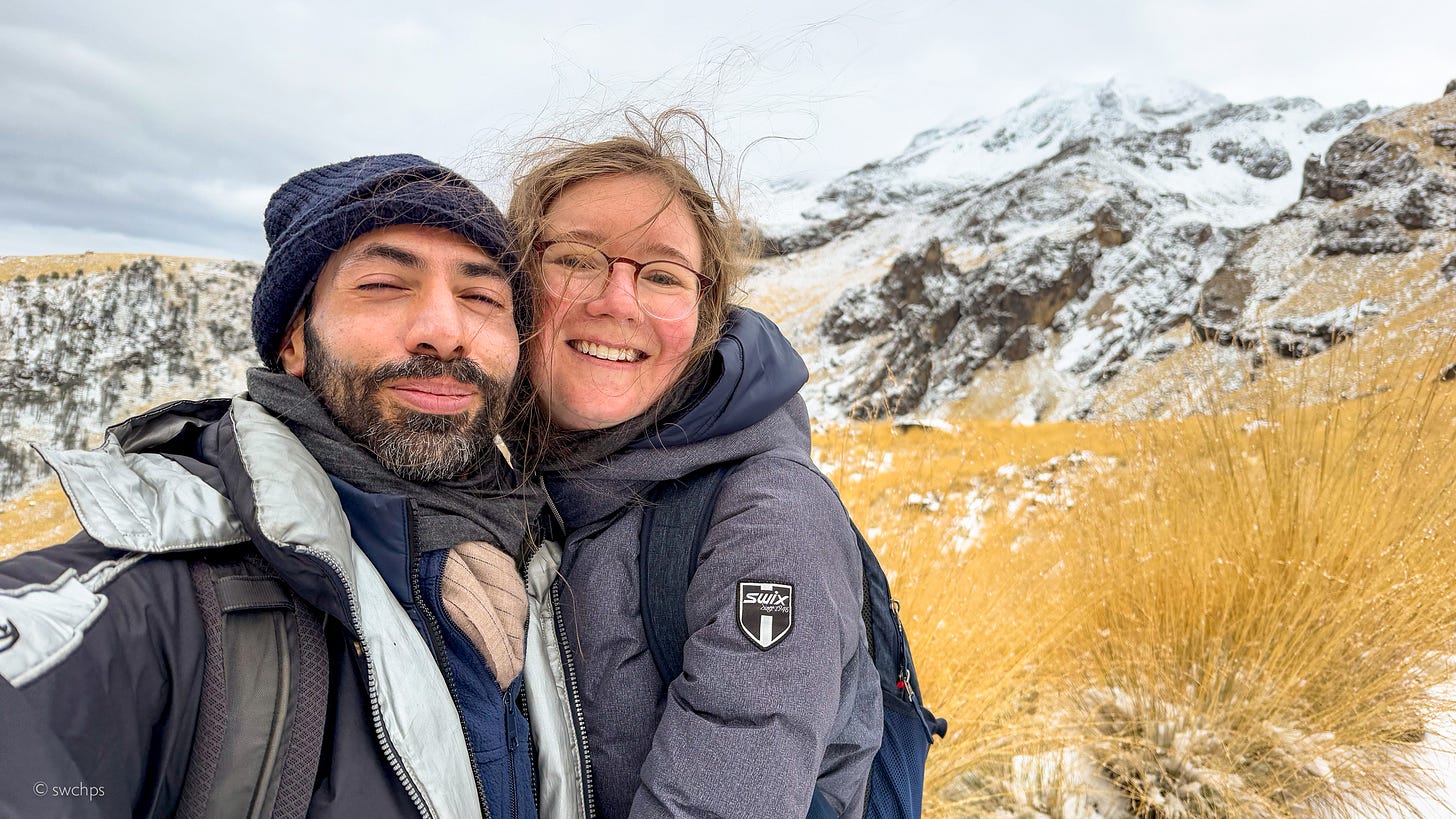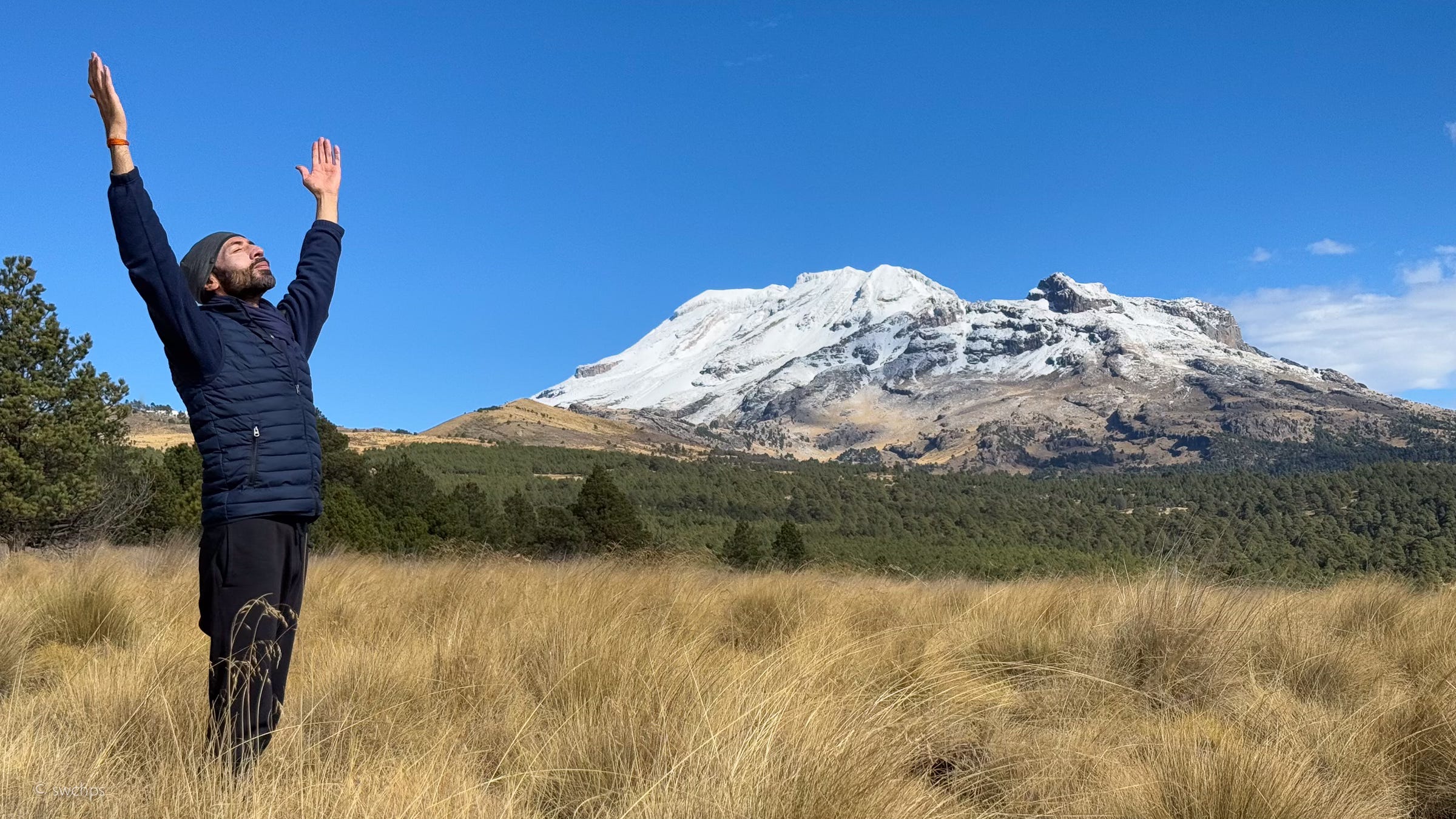3. Daring to Heal Part III
For Gene and Zoe, a trip to the mountains turns into an opportunity to reflect on the challenges of traversing together a chronic illness.
This is the third part in a series. See parts I and II in the links below.
Disclaimer: The information presented throughout this Substack series does not constitute medical advice. Consult your healthcare professional to assess your own health condition.
Unplanned
I remember first talking about it with Gene around the winter holidays, 2022–23, in Mexico City. We’d go up onto the roof of the building where we were staying as the sun was rising, and if the sky was clear, we could catch a glimpse of the volcanoes, towering above the sleepless city, their silhouettes seeming to float in the milky haze — before the smog rolled in, shielding them. With a shining face, he’d say, “Look, Zoe! Look!” It was during those gorgeous early morning visits to the roof that Gene started talking about the possibility of going there. It seemed remote at the time. A year later, the time seemed to be just right.
After much planning, five weeks after we decided to go for it, the day finally arrived. We’d stay for three nights, Friday to Monday, in cabins on the skirts of the Izta at an altitude of about eleven thousand feet, half an hour’s drive from the entrance to the road that leads to the Izta’s base. Gene and I would have a one-room cabin with two beds (very important, since he needs to be in his own bed to deep sleep), a fireplace, and a hot shower. Gene’s family would stay in two other cabins nearby. The day after arriving, on Saturday, we’d join Gene’s father, stepmother, brother, and a couple other family members — including two children! — for the ascent. At the last minute, another person joined the group: a decades-long friend of Gene’s dad and the current teacher of the Zen House in Mexico, founded by Gene’s father’s Zen teacher, Roshi Philip Kapleau, known as one of the founding fathers of “American Zen.” We’d be a big group of ten hiking the Izta that day.
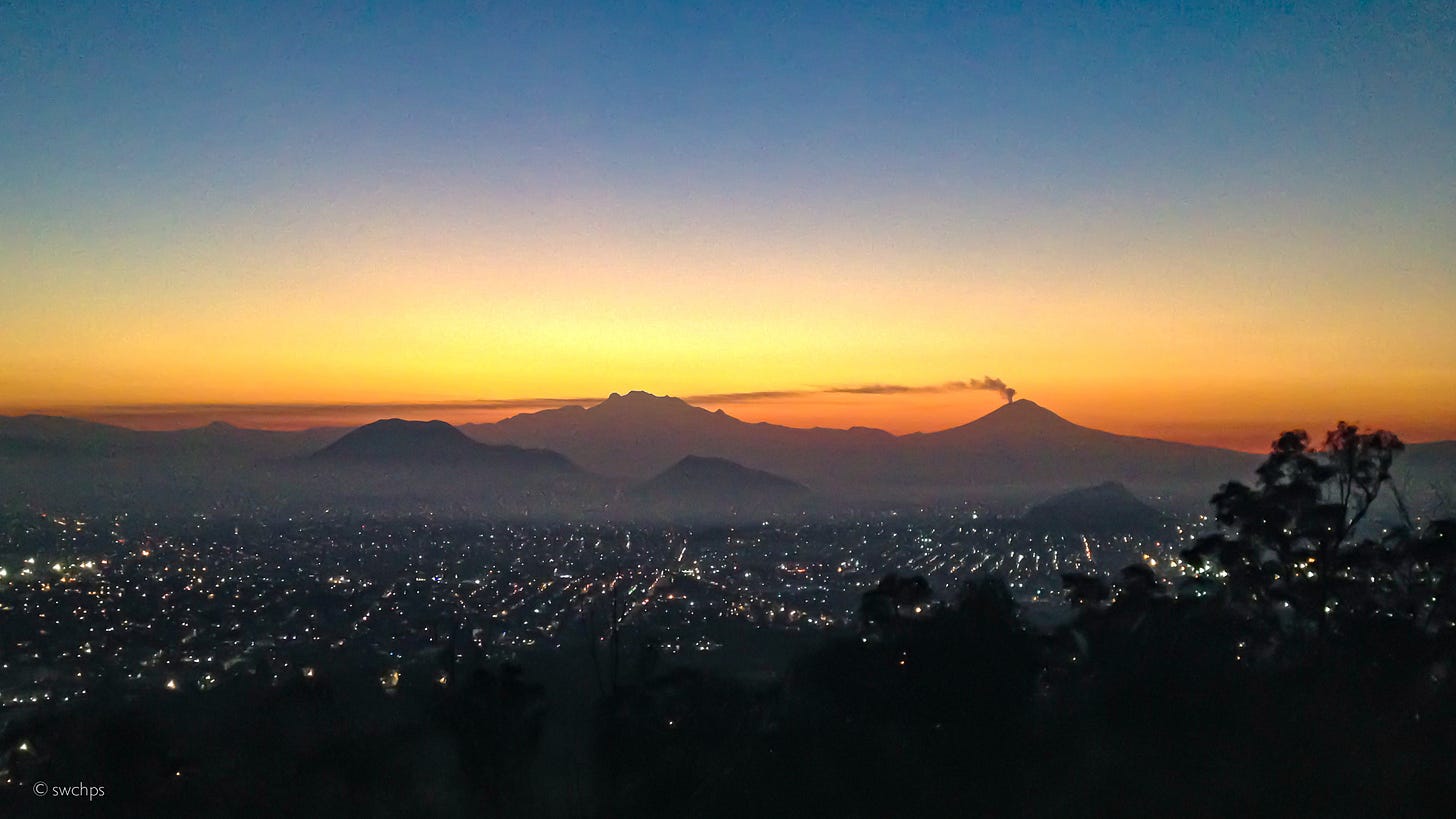
Day 1
It was already after sunset that we arrived at the cabins, after a long afternoon of driving. It was dark, cold, and — unexpectedly — rainy. Without any holdup, we quickly greeted each other and then went on to find our cabins, light a fire, and go to bed.
As planned, the next morning, Saturday, we woke up to the fire’s last embers glowing in a pile of ash and the sound of fat raindrops hitting the cabin roof. When we arrived at the entrance to the access road to the Izta at seven o’clock, we found that the weather god was in no good mood. This was supposed to be the dry season, and rain was unlikely — so much so that Gene, in all his preparing me for the mountain, hadn’t mentioned it. But on the very day we were to attempt our ascent, it was cloudy and drizzly. I had no clue where we were, or where the mountains were — we could barely see past the edges of the parking lot through the thick fog. And because of the bad weather, the access road was closed to cars. We were at twelve thousand feet, midway in the “saddle” between the two volcanoes, Izta and Popo, and as Gene explained to me, from there, you normally drive another four and a half miles to the base of the Izta, to a place called La Joya. From there, you start to hike by foot. But the access road was closed, and this meant that just to reach the base of the Izta, we would need to first walk four and a half miles up a muddy slope, rising from twelve to thirteen thousand feet.
After a short deliberation, the rest of the group said, “Okay, enough of this. It’s cold, it’s rainy. This isn’t going to happen. We’re going back down to the cabins and having some quesadillas for breakfast.” And they left.
How could they give up so easily?! I wanted to go on an adventure, not sit around eating quesadillas! Truth be told, I hadn’t taken Gene’s warnings very seriously. I was fit, I thought; I’d been training for this, and I liked taking on this kind of physical challenge — the kind that feels a little absurd, and that’s what makes it fun. I wasn’t going to be one of those people who sat down on a rock and started yelling that I wouldn’t take one more step! But here’s what I hadn’t anticipated: the biggest challenge of all would be accepting that we weren’t doing it. How could it be that, at the first sign of trouble, the grand plan, with all that it entailed — booking accommodations, planning, shopping and prepping for meals, gearing up, training, dreaming about it, arguing about it, Gene waiting years to be able to do it, driving for six hours to get up there — it all was dropped, so suddenly!
Gene and I were left there in the parking lot on our own. I was feeling frustrated. I needed to move! So Gene proposed the following: “The rain has practically stopped. Let’s go for a short jog on the road to the Izta. I shouldn’t jog, but I can walk, and you can jog back and forth ahead of and behind me.” Soon we were on the move, through the drizzling rain. It was misty, and we couldn’t see more than one hundred feet ahead.
After forty-five minutes, Gene was very tired. “Let’s go back and join the group for quesadillas and then have an easeful afternoon,” he suggested. I had such a long face that halfway back to the car, Gene stopped me and said: “Why are you concerned with what we don’t have? We’re here, at the Izta’s skirts, at twelve thousand feet! Look down there — it’s clearing up! The forest is beautiful! And listen to the wind! Have you ever heard the wind booming so loudly!? Let’s stop for a moment. Close your eyes, listen!”
It was, indeed, the loudest rustling, rushing sound I’d ever heard. The wind was thrusting consistently and so strongly that you had to get a good grip on the black, sandy, volcanic ground or the wind would push you down. At our feet was a field full of big tufts of golden yellow grass and, lower down the slopes, stands of short, hardy mountain pines. I glared down at them.
“This is what the mountain has for us today,” said Gene, already losing patience with my disappointed attitude, “and that’s perfect. Just receive it.” Truth is, I wasn’t ready to accept that it was so.
Gene looked depleted. The day before, he’d driven us from the place we’re staying in Mexico, on the other side of the Valley of Mexico, to the Izta. But we left late, got trapped in Mexico City’s Friday night traffic, and what should have been three hours turned into six — the last of which he was driving up steep curves, in darkness, through the rain. It was a very stressful travel day — for the both of us, but mostly for him. To make things worse, he barely slept that night. “My heart was pounding fast all night,” he’d told me that morning. “Must be the altitude. I got no more than three hours of sleep.” He suggested that, after taking a good nap that afternoon, we could discuss the possibility of making another attempt to climb the Izta the next day, Sunday. I was not happy. I didn’t think it would happen. But after jogging and walking for a while in this incredible high-altitude forest, I was almost ready to accept Gene’s proposal.
There was no phone signal, so we weren’t sure where the others were. We decided to return to the cabins and try to find them, maybe in the one restaurant nearby. As we drove down towards the cabins, our ascent receded further and further away, and I got more and more angry. “We came all the way here for nothing!” Gene tried to lighten me up a few times, but eventually he gave up, got exasperated by my dark mood and started yelling at me: “Why won’t you lighten up? Why do I have to put up with your frustration?!” We had a big argument, but when things calmed down a bit, he told me, “You know, the frustration and the anger are part of the purification the mountain is offering us. Remember what I said before? That the mountain would test us? Well, all this is part of that test.” I wouldn’t accept it. This wasn’t the test I signed up for! “You think you can come here and conquer the mountain,” Gene continued. “But the mountain has other plans for us. And because of the rain, we’re now forced to find a way to deal with our emotions. It’s all part of our ascent.”
Thankfully, that afternoon, Gene was able to take a good three-hour nap. Then, in the evening, we gathered with his family around the fire, told stories, roasted sausages and marshmallows, and Gene sang an Italian operatic aria, “Non Piu Andrai,” from The Marriage of Figaro, acting it out with great zest to help his ten-year-old nephew understand — and make him laugh. At that point, I was ready to let go of my attachment and of the feeling that I had to do this.
Day 2
On Sunday, the rest of the group would be getting up late, having a tranquil brunch, and going back to Mexico City. But Gene and I had made a different plan. We’d wake up early, drive up to the acces
s road, see if it was open, how the weather was doing — and, if all looked well, attempt another ascent. Before going to bed, Gene said, “Let’s prepare all our gear, just as if we were leaving for the mountain right now. Let’s set our alarm for 5:30 a.m. And tomorrow, when the alarm goes off, if we feel rested enough and if the weather is good, we go up. Agreed?” By then, I had come to terms with the fact that it just might not happen. I wouldn’t take it too seriously, I wouldn’t get my hopes up — but I thought it was a good plan. Then he continued, “And if we go, you’ll have to lighten up. No matter what happens or what we need to face up to, there cannot be any quarrels. Because if there is the slightest issue between us, the moment it starts, I’ll turn around and head back.” I said, “What the hell. Let’s try.” Gene built a big, blazing fire stocked with logs to last all night. The fire was hypnotic, and out the window, there was a beautiful, soothing spread of moonlight.
When my alarm went off at 5:30 a.m., I’d already been awake for an hour. I was restless. Since 4:30, I’d been trying to go back to sleep, but just as I was dropping off, I’d suddenly feel short of breath, gasp for air, and wake up again. Across the room, I could hear Gene breathing deeply. The cabin was super cozy and warm, all the embers still smoldering in the fire — while outside, I could hear sparse but heavy rain drops plopping onto the roof. Just like yesterday. Gene didn’t wake. He rarely sleeps so deeply, and I didn’t want to disturb that precious time. Fuck this shit, I thought. I’m not going anywhere! I turned off my alarm and went back to sleep, scuttling the plan.
About an hour later, Gene woke up, looked at the clock, and started yelling: “It’s past six! What happened?! Didn’t the alarm go off?!” “It did,” I mumbled. “I turned it off.” “Why did you turn it off? Why didn’t you wake me up?!” Gene got out of bed and, in a flash, started dressing up and gathering our gear — while I lay in bed, pretending not to notice.
Gene went outside, and when he came back, he said, “It’s not raining anymore. Let’s hurry up and go!” I didn’t care if it had stopped raining. I was not getting out of bed! Gene sat down, and we started talking, reconsidering our options. On the one hand, we were tired, and the weather did not look promising. On the other hand, we were already here! We’d been preparing for days, we’d made a big effort to come, and we had absolutely everything we needed ready to go. All we had to do was to get ourselves in the car. Were we going to give up at the last minute?
Gene found a quarter and convinced me to at least accept a coin toss. “Let Destiny decide,” he said. “Heads or tails?”
“Heads.” If it’s heads, we stay, I thought, but I said, “Heads, we go.” Gene spun the coin on the table and when it stopped, he exploded: “Ah! Heads! Heads! We have to go!” He’d secretly been hoping, like me, that the coin would tell us to stay and enjoy another few hours of sleep. But Destiny had spoken. Dreading it and determined at the same time, I got out of bed, and we quickly packed up all our stuff, grabbed our honey sandwiches, got in the car, and drove up to the entrance to the road to La Joya, hoping it would be open.
We arrived at seven thirty
and the weather was just like the day before, except a little worse: cloudy, misty, rainy — and as we pulled into the parking lot, it started sleeting. “Aguanieve!” Gene cried. Watery snow was accumulating rapidly on the windshield. I was surprised to see a dozen or so cars in the parking lot and a few hikers — dressed head to toe in rain gear and already dripping wet — starting out toward the access road on foot. The yellow barrier at the entrance was still down: closed to cars. Gene walked over to the park rangers’ building to register us for entering the park and came back thirty seconds later: “There’s nobody there! There’s a ‘closed’ sign on the door!”
I burst out laughing. It all seemed so ridiculous. We were ready, the coin had spoken, but everything was turning against us. Today, even the park rangers had thrown in the towel! But precisely because the situation was so adverse, that galvanized me.
I was still laughing when, without missing a beat, Gene said, “Let’s go! Let’s go! Let’s drink our electrolytes, get our stuff, and let’s go! Let’s see how far we can get. The worst thing that can happen is we get all wet and we’re forced to come back and change into dry clothes.” I was sure we were going to get soaked, we were going to freeze, and we were going to have to turn around — but I was all in on this absurd adventure. We gathered our gear, made our way through the rangers’ empty entry checkpoint, and started walking in the mist, through the sleet, up the muddy road, heading towards La Joya at the base of the Izta, almost five miles ahead of us.
We were walking fast, and we passed a lot of people on the road, all of whom, unlike us, were wearing long plastic raincoats. Some of them had fancy waterproof covers for their backpacks. They all looked far better prepared for the dreadful, inhospitable weather than us.
After forty-five minutes, having walked about one and a half miles, as we rose above the cloud sheet, the rain suddenly stopped. The ground was no longer wet and mushy, but instead, it was solid and covered with a light sheet of freshly fallen snow. There were no footsteps. The only marks on the snow were sporadic little bird prints. Except for the occasional chirp, it was dead quiet. The air was pristine. “Look over there!” Gene yelled. We thought it was going to be a misty day and we wouldn’t be able to see anything. But to our surprise, to our right, the clearing mist was revealing in the distance a glimpse of the majestic Popocatépetl, about seven miles behind us, crowned with a sheet of clouds, its flanks covered with a gentle layer of ice. It was a breathtaking sight. Looking at the splendid giant, I started to feel uplifted, even excited, and thought, Oh, we might be able to really make something out of this ordeal after all.
Still covered in mist and clouds,
the Iztaccíhuatl was invisible to us. We were about a third of the way to La Joya. Gene had been there many times, but he’d never had to walk this four-and-a-half-mile road just to start the steep ascent. Having to hike that access road was in itself a feat of endurance.
Not long after, we caught up to a group of three climbers who took a “shortcut” off the road and followed them, hoping to save time, but we ended up getting lost on a hill covered in snow and thick tufts of yellow grass up to our waist. At that altitude, trees can’t grow, so there are only tall grasses and small shrubs. Gene has a good sense of the topography up there and quickly found a way out. It was shortly after nine o’clock when, as we crested the grassy hill, the Iztaccihuatl first showed its snowy, rocky skirts, floating among layers of mist. Gene got so excited that he started running down the hill, feet deep in the snow, through the tufts of tall grass, grabbing onto them as he went to avoid falling. I scrambled to keep up.
Gene and I reached La Joya, at thirteen thousand feet, at around ten o’clock. Finally, we were at the base of the volcano, ready to begin the ascent. We recited the Ganesh mantras and began a brisk climb up a sixty-degree slope, navigating around rocks along a path made slushy and slippery by all the hikers who came before us, at every step trying to find my footing, trying not to slip and fall in the mud.
For all my “fitness,” for all my “training,” I was winded within seconds. (A seasoned-looking hiker on his way down saw me laboring up the slope, gasping for breath, and cried out encouragingly, “Sí se puede!”) Gene was going at such a fast clip that I couldn’t keep up, so he stopped every few minutes and waited for me. Not only was he making his own way with great endurance, exuberance, and care, but he was also guiding and encouraging me through this totally new experience. He showed me where to put my feet and how to find support to climb up and down sharp, slippery slopes of snow mixed with rocks and sludge. He taught me how to avoid the slushy path when possible and find a way through fresher, firmer snow. He kept track of when and where was a good time to stop to have a drink, take a bite, reapply sunscreen, out of the frigid wind — and then keep on going.
Every now and then,
we stopped and tried to take in the landscape: golden yellow grass below, white snow and black rocks ahead, incredibly vast views of the whole Valley of Mexico, and the rapidly changing weather, clouds sailing in and out and the sun breaking through. It was dizzying to stand on the narrow path, your gaze plunging down the steep, grassy slope at your feet, across the deep yellow valley before you through a huge, swimmingly clear expanse of air, then sweeping up snowy white slopes and black, stubbly scree all the way to the clouds, hiding the Izta’s peaks behind them.
We passed a few other hikers on the way up who’d stopped to have a snowball fight, standing right in the middle of the path, shrieking and laughing and chucking snowballs at each other like children. They seemed delighted by the novelty of it. The yellow mountain flowers we walked past, glazed with ice, seemed surprised by it, too. I marveled at the mere fact that we were there; that we were able to do this, physically and mentally, with exuberance, joy, and wonder in the experience, with a lot of care and thoughtfulness, taking care of each other — if only so that we could make it back to the bottom in one piece. I was surprised at how strong Gene looked. He didn’t have any dysautonomic problems. He didn’t get dizzy or anxious. He spent the whole day outside, under the sun, which is no small thing for him — because of the antibiotics he takes, he burns easily, so he normally hides from the sun in a dark room with the curtains drawn all day long. What’s more, despite the huge effort, he had no injuries throughout the day, and no problems with his knees or his legs — not then or afterward. He seemed happy and strong up there: in his element.
The climb was truly a test for me because I’d never attempted anything close to it. But Gene thought I could do it, and because of that, I felt at ease. I believed we could achieve what we’d set ourselves to do, because he believed it, so I could let any fears, doubts, or questions go and just focus on the next step and the next marvelous sight. That was Gene’s gift to me. I put myself in his hands and just tried to do what he said as best I could.
But going up is one thing. Then there’s the way down. As difficult as it was to climb the steep slopes, as much as my thighs burned, my heart pounded, and I gasped for breath, that was easy in contrast with the mere idea of going down — I found that even more defiant. When I turned around and loo
ked back at what we had climbed, the deep snow with its slippery surface and who knows how many pointy black rocks lurking underneath, I thought, Oh my God! How are we going to get down?

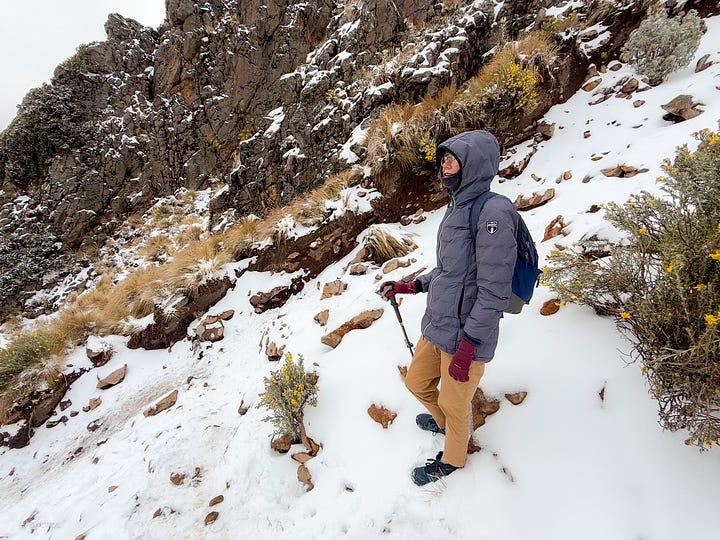
After climbing from La Joya
at a constant pace for about two hours, we reached the massive rocks that make up the White Lady’s feet, at 14,400 feet. From there, we could see towards both sides of the Izta, the immense eastern and western horizons. On one side rose the majestic Popocatépetl, half covered by clouds, followed by huge valleys and the faraway ranges down below — we were looking down on the peaks of smaller mountains, blue in the distance. On the other side, we could see the whole patchwork of the Valley of Mexico and much, much farther. The sight was astonishing. It’s the kind of view I’d only ever seen from a tiny airplane window — and we’d gotten here on our own two feet. The Izta itself felt like an alien land. All around us rose massive black rocks, their faces feathered with the most delicate white snow. The grasses and clumps of yellow flowers at our feet were coated in ice, blown by the wind into spiky shapes, all pointing the same way — like a physical manifestation of the wind’s power.
We sat down on a rock in the snow to take a break, admire the landscape and have a drink of electrolytes and a power bar. Not a minute later, the first group of climbers we’d seen for the past hour passed us by as they made their descent. They seemed exhausted and jubilant.
“Where are you coming from?” asked Gene.
“From el refugio,” they replied, with worried faces. Gene explained to me that the “refuge” was a small hut with a few bunk beds, halfway between our current location and the Knee. It’s the highest shelter in the Izta, at 15,500 feet, where climbers spend the night when attempting to summit at the Knee or at the Chest early the next morning, with the most incredible sunrise. “We were trapped in the refuge all morning,” they said. “There was a massive storm. We had no visibility, and the winds were furious. It got very dangerous. Only a couple hours ago were we able to begin our descent.”
Gene nodded, reassuring them, and with a smile, he said, “It’s great that you’re back! Welcome back!”
He didn’t seem bothered by the climbers’ story. Up there, he explained, the weather changes very rapidly — so you must always be watchful. The climbers had the bad luck to be caught in the storm, but the weather had shifted by now, and we were not at risk. “Regardless, just to be safe, unless you’re spending the night at the refuge, you must begin the descent at 2:00 p.m. at the latest to make sure you reach La Joya before sunset.”
It was 12:30 p.m., so, Gene said, we could still attempt to climb for another hour or so — but it would be an even more challenging path. By now, at the feet of the Izta, I was already feeling very cold. My legs were tired. My whole being was tired. I didn’t think I could go any further. I didn’t want to go any further — this achievement was enough to satisfy me. Gene, however, was thriving. He looked into the distance with such yearning. A gentle wind came up behind us, nudging us to keep going. It was playfully pushing us forward, as if to say, Come on! Then the mist floating up high opened just a little, revealing the Knee’s peak. “The mountain is teasing us to keep going,” Gene murmured. I’m sure that if he’d been there by himself, he would have continued ascending. For my part, I was more concerned about getting down in time to have a steaming hot chicken soup at the restaurant before it closed (and restocking our firewood for the night) than anything else.
Staring at the path ahead, towards the Knee, Gene said, “For the next hour, it may be quite misty, so you won’t be able to have wonderful views anymore. The only thing you’re going to see is our way back getting longer and longer. And the next leg would be a steep incline on very sandy terrain. It all may be a bit too much for you, your first time. Perhaps it’s best to call it a summit right here, at the Izta’s feet, take in the view for a few more minutes, and start our way down.”
We sat for a commemoratory portrait. Then we recited a verse of a prayer, before starting our descent.

Coming down,
at first, I was terrified. I was hunched over, with my back bent, because I was scared to stand up. What if I slip and fall? I couldn’t understand how Gene could be so relaxed going down — in fact, he looked the happiest he’d been all day. At some point, he turned around, saw me crouching there, and said, “You don’t have to be bent over like that. You can straighten up. You won’t fall. It’s all right.” Many times that morning, he’d reminded me that it’s a very personal choice where you put your foot next, the path you make for yourself. But this time, he suggested I follow in his footsteps. By having me follow him, he was showing me how to crab walk sideways, finding the fresh snow, which is more supportive than the slippery path many other climbers have walked on. Walking in his footsteps, literally, helped me to get a feel for how I should walk — with confidence. And once I started to get comfortable and realized I wasn’t going to fall and hit my ass bone on a rock, I started to have more fun with it. So we began descending fast, on light feet. It felt to me like we were flying. Gene was leaping down like some kind of mountain lynx — and I was scrambling behind him, taking a little leap with each step, equal parts terrified and thrilled. It was a powerful experience of trust, in him as in myself.
At this point, I saw something incredible. The weather started putting on a show. Gene had told me that, according to legend, up here was the home of the weather god and his attendants — and this is when I started to understand why and to feel their presence up there, working their wonders, almost for the fun of it. Just as we reached a gentler slope and I started feeling more secure, out of nowhere, it started snowing — upward! The wind was moving soft sprinkles of snow towards the mountain, and as it approached, the curvature of the hill made the air turn upward — and so, too, the snow. Watching the snowflakes dancing up through the air toward us, I noticed that beyond it, a white behemoth of a cloudbank was sailing quite quickly from the Valley of Mexico and into the “saddle” between the mountains — straight toward us. It seemed to be miles away, but within seconds, it had enveloped us, completely veiling the view towards the Popocatépetl — and sweeping us up in the fog. In the distance, we heard a mild rumble. Gene told me it was far-off thunder. I didn’t know if I should get nervous — everything was changing so fast — but at no point did I see him worry. So I decided not to worry, either.

Many aspects of the day
were profoundly personal and intimate, and, at the same time, we were sharing the whole experience — I felt we were more in sync than we usually are, in day-to-day life. It seems to me now like a metaphor for the journey of life: you have to find your own personal path, yet (if you’re lucky) you’re going through it all together, trusting each other fully.
Sometimes, at ground level, when Gene tries to give me advice, I bristle. I have eleven more years’ experience in the world than you do, he’ll say. Can’t you just listen to what I have to say? Could it be that I have something to offer? But stubborn Capricorn that I am, I get skeptical, or defiant (or both). I have to see for myself, or I have to try it my own way before I’ll give in and try his (even though I’ve learned by now that 99.2% of the time, his way works). But up there, for once, I let go of my skepticism and just trusted him. There was danger up there on the edge of that mountain. What else could I do? I was very aware that he’s been climbing it for as long as I’ve been alive. Every step he took showed it. I had no idea what I was doing, and I knew that, and I was fine with it — because I had the steadiest, most attentive guide. I knew that if he was asking something of me or telling me to do something, it was for a good reason. All I had to do was listen, do as he said, put one foot in front of the other, and marvel at the mountain’s beauty.
Yet, while feeling guided and supported by him, I was also there to care for and support him so that he could enjoy this super special day, going back to his beloved mountain having come back from the abyss of such a complex disease. We were doing this together, as a team, supporting each other every step of the way — literally. As he guided me through the most difficult terrain I’d ever walked on, I was also looking out for him in my own way, checking in on him, asking if his knees were doing okay, and at every break, feeding him honey sandwiches.
The experience of the mountain gave me a perspective on our life journey: how we trust and take care of each other, living intensely in a very personal world but also sharing it. Learning how to be bold, reasonable, resilient yet also to let ourselves be cared for. And take chances to show care.
Recently, Gene and I were talking about the word caregiver. I told him I hate it. “Well, let’s not use it!” he said. (I didn’t know you could do that!)
What we came to is that everyone gives and receives care, sometimes both at the same time. If we are sick, we may receive; if we’re healthy, we may give. Even if we’re sick, we may still give. But any of us may find ourselves in the position to give or to receive, at any time. Many times, over the past few years, Gene has taken care of me. Through dog bites, tick bites, hives, pustules, yeast infections, food poisoning, a persistent armpit swelling — he’s taken me to doctors’ appointments and to get tests done, badgered me into taking my medications… It’s not like he stepped out of the “patient” role or put on a “caregiver” costume to do any of it — he just saw opportunities to care for me and he took them. He does it every day.
So maybe words and roles like patient and caregiver aren’t that useful. They don’t describe the interplay of constant giving and receiving in any relationship, regardless of who’s chronically ill and who isn’t. Life (with illness, without it) is a series of opportunities to care. Life with Lyme just gives you a lot of them. You take them or you don’t.
I was glad that we were able to do this climb, and with such joy and excitement — even though it was a daring challenge. Inspired by the way Gene looked at, and spoke about, and spoke to, the mountain, I found myself thinking, as we descended, Thank you for letting us be here. Thank you for letting us climb you. Thank you for showing us your beauty.
Near the end,
Gene and I were greeted by two members of the alpine rescue team. They asked us how we were doing and if we’d seen anybody else up there. “We’re doing well, thank you. And no, we didn’t see anyone else.” It turned out that the rescue team was waiting for us. They’d heard we were the last two people up there, and on learning that we were safe and that there was no one else behind us, they began sweeping the paths, making sure all climbers made their way down. They’d assessed that weather conditions could take a turn for the worse, and they didn’t want to have to rescue anybody that day. Going down, in the last ten minutes, we must have passed a couple dozen climbers starting their ascent, dressed to the nines and filled with buoyancy, who were mercilessly turned back by the rescue team. Even police officers were turning people away. It seemed that they were expecting a bad storm.
For me, the most fun part of the climb came after that, toward the end. The path was a slippery mix of slush and black dirt, and Gene showed me a way of half walking, half sliding down — kind of skating on the bottoms of his feet. I was too scared to do it standing up, but I realized that if I squatted down and propelled myself forward with my hands, I could slide on both feet. The last twenty feet of steep slope down to the base camp area, I slid through the slush, cackling.
Then, just as Gene and I reached La Joya, the clouds around the Izta began clearing, the sun came out, and we got to experience the full sight of the snowcapped mountain, showing its beautiful, brilliant white face. It was as though the Izta was pleased with our visit, with our effort, learning, and companionship. In the end, there was no storm, but beautiful afternoon light bouncing off the face of heaven.
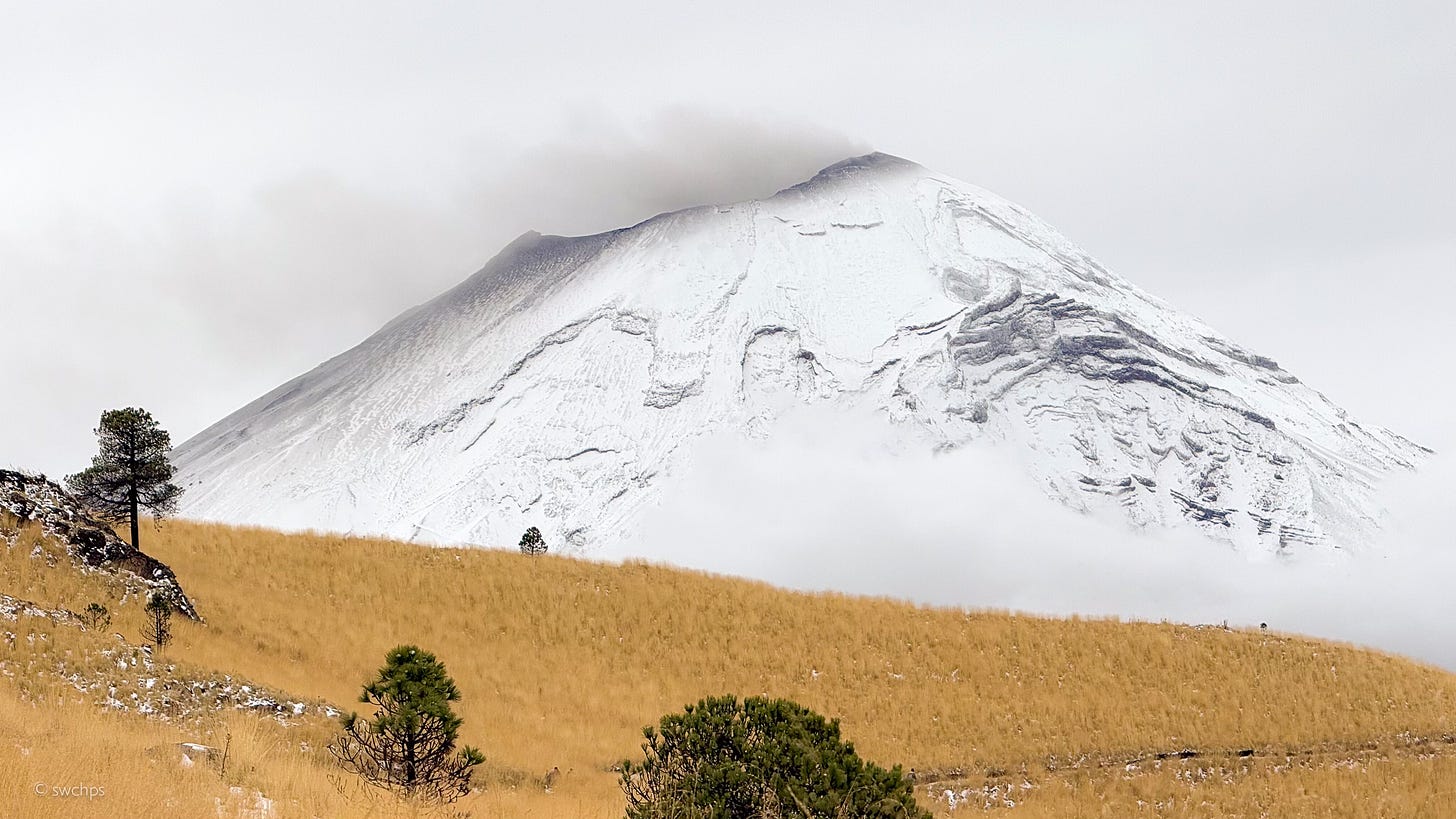
We wanted to make it to the hut back in time for hot soup and to restock our firewood supplies for a warm night. We hung out for a few minutes at La Joya, taking photos, slathering on sunscreen, gazing at the changing face of the mountain and grinning from ear to ear. On a rock next to us sat a little snowman someone had made, with yellow mountain flowers for eyes. And then, galvanized by the thought of hot soup and a warm hut, for the remaining four and a half miles back from La Joya to the parking lot, Gene and I half walked, half hiked, half ran. Both of us were feeling drained but also exhilarated by the whole experience — which just kept unfolding. We were having fun, running down the hill and passing a lot of people on the path. Who could have thought that I was there for the first time, or that this was Gene’s first visit in nine years, having survived four and a half years of antibiotics while facing up to one of the most defiant bacteria infecting his nervous system. Yet, there we were!
From time to time, we turned around and saw how all the clouds had cleared, revealing both volcanoes, Popo and Izta, in their fullness for the first time that day. We could see all the way up to their craters: the Izta at peace, glazed by shiny snow and ice, the Popo, steaming splendidly into the sky, smoke billowing from its peak and being taken away by the winds. An incredible sight! The Popo has such an unmistakably living presence, breathing, almost slumbering, and yet full of incredible power and potential deep within this outlet of the power of the earth. I had never seen anything like it before and I found my eyes drawn to it again and again, totally in awe.
By the time we made it to the car, I had never been on my feet for that long. We had walked in difficult conditions, with just a few brief stops, for more than eight hours. I’m very happy that I was able to do that with him. By the time we started out, I didn’t have expectations, but I’m very satisfied. Next time, however, I want to go all the way to the top.
The Mountain, Illness and Health
Gene’s Reflections
After nine years, it was so nice coming back to the Izta, reconnecting with such a familiar feeling, recovering a small part of who I knew myself to be. But it was also an opportunity to reflect on life, sickness, and what it means to be healthy.
Being there is surreal. I don’t think there’s anything quite like it. The journey of climbing a mountain is a very articulate metaphor for the journey of traversing an illness, especially a chronic illness — when you are sick day after day, month after month, and sometimes year after year. There’s nothing metaphysical about it. It’s just a very simple analogy.
Coursing though a long illness and climbing at high altitude are both big challenges. There’s difficult terrain to endure. You need to know where you’re going. You need to know how to go. You need a good guide. Sometimes you are cold. But you know that if you stop, you’ll freeze, so to stay warm, there’s nothing better to do than keep on going, putting one foot in front of the other. Sometimes, as you climb, you’re surrounded by vertiginous scenery, and the slopes may be frightening. But you can’t let yourself be overwhelmed by fear — you must soothe yourself and keep on going. Sometimes it can feel frustrating that all your efforts seem to take you nowhere. But if you focus on your goal and move just a little and then another little bit, you’ll eventually find that you’ve made good progress: you’ve conquered yet another rocky wall.
When you’re up there, it becomes evident that social and cultural references and conventions are but role playing — there’s only a relative truth to them. In the mountain, however, you come face to face with blunt reality.
In the mountain, as in a life of being chronically ill, when despite all the challenges, you just focus on your next step, sighting your next goal, staying present, a unique part of you awakens. The experience is not so much a change of scenery as it is an opportunity for finding a new reference point against which you measure yourself. Its power forces you into a new dimension of yourself, one that you’re not used to or didn’t even know you had in you.
But it’s only when you come back down and begin to reengage with the rest of life that you reflect on what it meant to be up there. Back at ground level, the mountain appears so small it could fit between your fingertips — but you know it’s anything but small. Similarly, when you come back, even if you don’t seem to be great, you know so well that you are anything but small.
The analogy continues:
When you are on the mountain, you know that you’re making a huge sacrifice. To begin with, you’re sacrificing your time. You’ve barely slept, and every single step weighs a hundred times what it otherwise should. You know, you feel, how much of your life force goes into each step. It’s tough. But when you’re on that path, you have little choice but to keep making the sacrifice. And if you’re too concerned with the sacrifice… Oh, I’m putting in so much effort here. I’m losing months and years. What’s happened to my productive years — they’re gone. This is so expensive. I’ve had to put so many things away, give up so many experiences, so many friendships… If you think like that, well, you can never begin to enjoy the path you’re on — and you can never enjoy anything. You go rolling down. But if you can let go of your apprehension, then you can begin to enjoy the little miracles — and the gigantic miracles — that occur along the way. If you can give up your fear and your anxiety, then you’ll find how much beauty surrounds you, even in places you couldn’t ever have imagined. The world becomes so beautiful. Every moment can be precious.
It’s fine to be afraid. It’s fine to feel overwhelmed, angry, sad. It’s fine to know you’re making a sacrifice and giving up all those things. Yet when you can look past the idea of being “ill,” you discover that the rock you thought was barren is teeming with life. You can forget that you were ever healthy or sick, because under the mighty sky, you are, simply, alive.
The journey is a long one. Through it all, at every step, your body is challenged, your mind is challenged. There can be so much pain. So you must be sensible and careful in the way you go about it all. You must be gentle with yourself. It’s all right to feel low. And it’s all right to find good, supportive company. As you go on, despite the constant challenges and pain, you gradually become more and more attuned to your true nature, your “mountain-nature,” and you learn to take care of this little piece of the world you call yourself.
What do you do when you’re walking the mountain? You don’t tell yourself, Oh, I’m walking the mountain. No. You just walk and enjoy what you can. Likewise, when you’re sick, you can’t go around saying, Oh, I’m sick. Oh, I’m sick. No. You just put up with the journey and enjoy what you can. Don’t speed too much, but don’t lag, either. You are up against something that’s too powerful to fight or to fully understand. It can suddenly get very cloudy, and from one moment to the next, you lose all visibility. So you need a guide, someone who has walked the path, to help you move safely. Don’t do this alone. And if it ever gets too overwhelming, don’t despair. There will be blue sky days, and there will also be darkness and storms. When you accept that, then they both become worthy experiences, and you can learn to be at peace with the storm.
There are many parallelisms between climbing the mountain and undertaking a challenge such as being chronically ill. But the strongest analogy I find between them is how much beauty you can capture when you are up there and bring down with you when you come back.
In the next issues of Ixodia:
Zoe and Gene speak with several heros on the frontlines of the Lyme and associated diseases epidemic: patients, caregivers, practitioners, healers, advocates, relatives, friends, researchers, policymakers… Their narratives portray the intimate, day-to-day struggles and triumphs of facing up to an enigmatic disease.
Coming soon!
Disclaimer: The information presented throughout this Substack series does not constitute medical advice. Consult your healthcare professional to assess your own health condition.The opinions and recollections expressed by persons featured in the Ixodia series are solely theirs and don’t reflect the opinions or beliefs of the editors or their affiliates. In the nonfictional stories presented, some names and characteristics have been changed, some events have been compressed, and some dialogue has been recreated.





